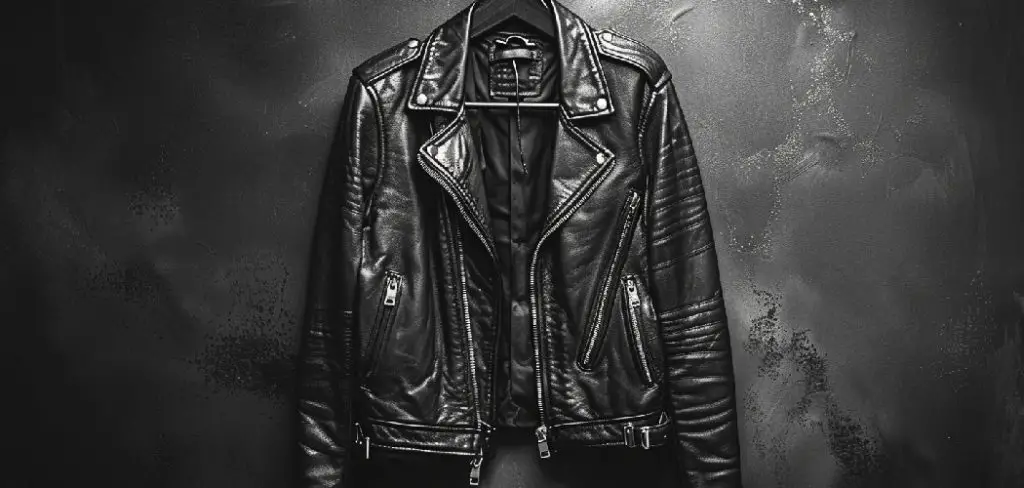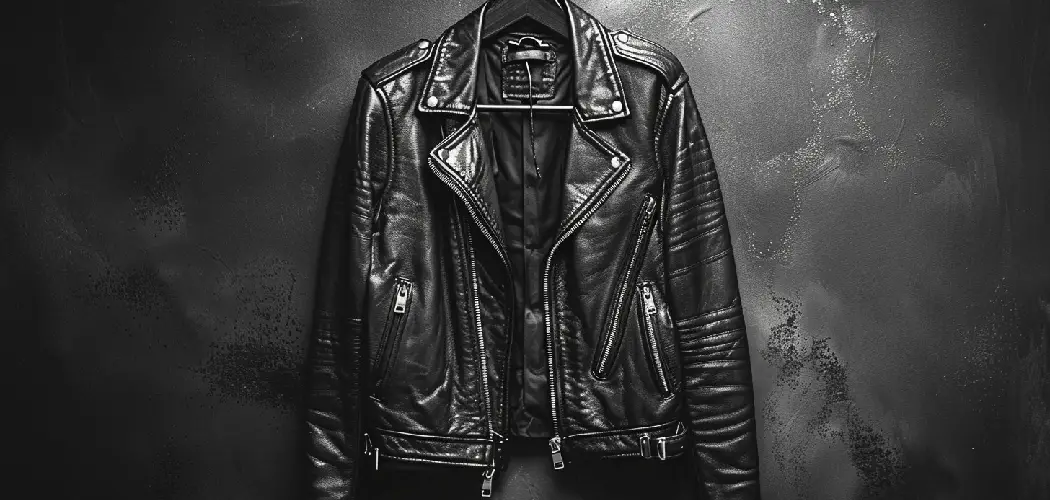To repair a faux leather jacket, you need to gather materials, apply adhesive, and use a heat source to seal the repair. Faux leather jackets are a fashionable and affordable alternative to real leather.
However, just like real leather, they can become damaged over time. Whether it’s a tear, puncture, or discoloration, a faux leather jacket feels ruined once it starts to show signs of wear and tear. Instead of tossing out the jacket, you can attempt to repair it at home.
With some basic materials and a little bit of patience, you can get your faux leather jacket looking almost as good as new. Here, we’ll go over the steps for repairing your faux leather jacket so that you can look stylish and confident once again.

Assessment Of The Damage
Overview Of Common Damages
Faux leather jackets are popular for their affordable price and stylish appearance. However, they are not as durable as genuine leather. Faux leather jackets are subject to wear and tear, just like any other material, but there are some common damages you should look out for:
- Peeling of the top layer
- Scratches and cracks
- Flaking and drying out
- Fading of color
Steps To Assess Your Faux Leather Jacket
Assessing the damage to your faux leather jacket is crucial before attempting any repairs. Here are a few simple steps to follow:
- Take a close look at your jacket and identify any damages or areas that need repair.
- Use a magnifying glass to detect any signs of cracking, peeling, or flaking.
- Check the seams and zippers for any damages.
- Gently stretch the fabric to check for any signs of wear and tear.
- Look for discoloration or fading of color.
Photos To Help Assess Damages
Taking photos of your damaged faux leather jacket can be helpful in assessing the intensity of the damage. Here are some tips on taking photos:
- Take photos of the whole jacket to show the scale of the damage.
- Take close-up shots of the damaged areas to show the extent of the damage.
- Take photos in natural light to show the true colors and textures of the jacket.
- Make sure the photos are clear and well-lit.
Following these simple steps can help you assess the damage to your faux leather jacket and determine the best course of action for repairing it. Remember, the key to successful repairs is identifying the damage accurately and taking the necessary steps to fix it properly.
Mending Faux Leather Tears
Faux leather jackets are gaining popularity as they give the desired look without compromising on the ethics of animal welfare. They are quite affordable, but still not immune to wear and tear. Faux leather jackets tend to lose their appeal over time due to constant usage, and the most common issue faced is a tear.
Mending faux leather tears can be a daunting task, but with the right tools and knowledge, it is not that difficult. In this blog post, we will provide a comprehensive guide on how to repair a faux leather jacket, with a particular emphasis on mending faux leather tears.
Preparation
Before starting to repair the faux leather jacket, it is essential to gather all the necessary tools. Here is a list of tools that you will need:
- Faux leather patch
- Fabric glue
- Sharp scissors
- Pen and paper
- Clean and dry cloth
Once you have all the necessary tools, find a clean and flat surface to start working on.
Faux Leather-Specific Mending Practices
Mending faux leather tears is different from repairing genuine leather jackets. Here are some tips to mend faux leather tears successfully:
- Faux leather can’t be sewn back like genuine leather, so avoid using needles for mending.
- Use fabric glue to fix faux leather tears instead of stitches.
- Cut the faux leather patch according to the tear size to get the best results.
Types Of Faux Leather Patches
There are various types of faux leather patches available in the market, and it’s essential to know the difference between them to decide which one to use. Here are the three most common types of faux leather patches:
- Peel and stick patches: These patches are the easiest to use, as they have an adhesive layer that sticks to the tear.
- Iron-on patches: These patches are more durable as they are heated, which activates the adhesive and bonds to the fabric.
- Sew-on patches: As the name implies, these patches require sewing to the jacket, making them difficult to use for mending tears.
Step-By-Step Guide To Mending Tears
Here is a step-by-step guide on how to mend tears in a faux leather jacket:
- First, clean and dry the area around the tear.
- Cut the faux leather patch according to the size of the tear, with a slight overlap to ensure maximum coverage.
- Apply fabric glue to the backside of the patch and the edges of the tear.
- Carefully place the patch onto the tear and press it down firmly.
- Allow the glue to dry completely before using the jacket.
Repairing a faux leather jacket requires the right tools and knowledge, and the process can be manageable with the appropriate steps. Hence, it’s essential to know how to mend tears in a faux leather jacket effectively. With the help of this guide, one can easily mend tears without compromising the look of the jacket.
Restoring Faded Faux Leather
Faux leather jackets are a great alternative to real leather, as they are more budget-friendly and vegan. However, over time, faux leather jackets can fade and lose their luster. The good news is that it’s possible to restore color to your faded faux leather jacket.
In this section, we’ll cover the types of faux leather dyes, color-matching tips, “do’s and don’ts” for dyeing faux leather, and a step-by-step guide to dyeing your faux leather.
Types Of Faux Leather Dyes
There are two types of faux leather dyes that you can use to restore color to your faded faux leather jacket:
- Water-based dye: This type of dye is eco-friendly, easy to use, and doesn’t require any special equipment to apply. Water-based dyes are best for restoring small areas of faded faux leather, as they can be applied with a brush or sponge.
- Solvent-based dye: Solvent-based dyes are more durable than water-based dyes and can restore the color to large areas of faded faux leather. However, they can be toxic and require proper ventilation and protective gear to apply.
Color-Matching Tips
Matching the color of your faux leather jacket can be tricky, especially if it’s an odd or unique color. Here are some tips to help you match the color of your jacket:
- Take a small swatch of your jacket, such as a pocket or scrap piece, to your local craft store and compare it to their dye selection.
- If you can’t find a dye that matches exactly, choose a darker shade of the same color and mix it with a lighter shade until you achieve the desired color.
- You can also try using a leather paint or acrylic paint to match the color of your faux leather jacket.
“Do’S And Don’Ts” For Dyeing Faux Leather
Before you start dyeing your faded faux leather jacket, here are some “do’s and don’ts” to keep in mind:
Do:
- Test the dye on a small, inconspicuous area before applying it to the entire jacket.
- Prep the surface of your jacket by cleaning it thoroughly with a deglazer or rubbing alcohol.
- Apply the dye in thin, even coats and let each coat dry fully before applying the next one.
- Use a heat gun or hair dryer to help speed up the drying process.
Don’t:
- Use regular clothing dye on your faux leather jacket, as it won’t penetrate the surface properly and may come off on other clothing items.
- Overload your brush or sponge with dye, as it can result in an uneven application and may cause the dye to bleed into other parts of the jacket.
- Apply heat directly to the surface of your jacket, as it can cause the faux leather to melt or warp.
Step-By-Step Guide To Dyeing Your Faux Leather
Now that you have all the necessary information, here’s a step-by-step guide to dyeing your faded faux leather jacket:
- Clean the surface of your jacket with a deglazer or rubbing alcohol.
- Apply the dye with a brush or sponge, working in thin, even coats.
- Let each coat dry fully before applying the next one, using a heat gun or hair dryer to speed up the process.
- Once you’ve achieved the desired color, let the jacket dry overnight to set the dye.
- Apply a sealant or finisher to protect the color and increase the durability of your newly restored faux leather jacket.
With these tips and instructions, you can restore the color and life to your faded faux leather jacket and get many more wears from it.
Cleaning And Protecting Faux Leather
Faux leather jackets have become increasingly popular thanks to their durability, functionality, and affordability. It’s an excellent alternative to leather jackets, but if yours needs a refresh or a deep clean, here’s how you can clean and protect faux leather to keep it looking brand new for years.
Use Of Cleaning Agents For Faux Leather
Cleaning your faux leather jacket is the first step to maintaining it. Here are the key points to remember:
- Always spot test any cleaning agent you plan to use on a hidden area of the jacket first.
- Use a solution of mild soap and warm water to clean your faux leather jacket.
- Avoid using harsh chemicals like bleach, acetone, or alcohol.
- Do not machine wash or dry clean your faux leather jacket.
How To Clean Without Harmful Chemicals
It’s essential to avoid using harmful chemicals when cleaning your faux leather jacket. Here are some tips:
- Use a damp cloth to wipe down the jacket.
- For a more thorough cleaning, mix equal parts white vinegar and water and spray the solution onto the jacket before wiping it down with a clean, damp cloth.
- Baking soda is an excellent alternative for removing stains. Mix it with warm water and apply using a soft cloth to the affected area and let it sit for 10 to 15 minutes before wiping clean.
Protective Measures To Keep Your Jacket Looking Like New
Preventive measures are crucial to protect your faux leather jacket from damage. Here are some key points:
- Store your jacket in a cool, dry place and avoid exposing it to direct sunlight.
- Never fold your jacket as it can damage the material. Hang it on a padded hanger instead.
- Apply a protective spray to your jacket to protect it from water and stains.
- Avoid wearing your jacket in the rain as moisture can damage the material.
Tips To Maintain Faux Leather
Maintaining your faux leather jacket can ensure its longevity. Here are some tips:
- Wipe down your jacket regularly with a soft cloth.
- Avoid rubbing or scratching the material, which can cause damage.
- Keep your jacket away from sharp objects.
- Apply a leather conditioning cream to keep the material hydrated and moisturized.
By following these easy steps, you can easily clean and protect your faux leather jacket and keep it looking fresh and new for years to come.
Frequently Asked Questions Of How To Repair A Faux Leather Jacket
How Do I Know If My Faux Leather Jacket Is Repairable?
If your faux leather jacket has minor damages such as scuffs, scratches, or small tears, it’s usually repairable. However, if the damages are too severe, like large holes or rips, it may not be fixable.
What Materials Do I Need To Repair A Faux Leather Jacket?
You’ll need a few materials such as faux leather patch, adhesive, scissors, sandpaper, and a fine-tipped brush. Also, if your jacket is colored, you may need acrylic paint to match the color of your jacket.
Can I Repair A Faux Leather Jacket With Embroidery?
Yes, you can repair a faux leather jacket with embroidery. Embroidery can add a beautiful decorative touch to your jacket and effectively cover small tears or damages in the fabric. However, it is essential to match the embroidery thread color to your jacket’s color.
How Long Does It Take To Repair A Faux Leather Jacket?
The duration of the repair depends on the extent of the damages. If it’s a minor scuff or scratch, it’ll take about 30 minutes to an hour. However, if it involves repairing large holes or tears, it may take up to 2-3 hours or longer.
Is The Repair Of Faux Leather Jackets Costly?
No, repairing faux leather jackets is usually inexpensive. Most of the materials needed are readily available and affordable. However, if you’re not confident in repairing it yourself, professional repair services may cost you a little extra.
Conclusion
Maintaining your faux leather jacket is crucial if you want it to last a long time. It’s evident that it’s not easy to safeguard it from all types of damage, but the good news is that restoration methods exist. Repairs can seem intimidating at first, but by following the steps highlighted above, you are equipped with the knowledge needed to fix your jacket with ease.
Tackling minor issues such as scratches and scuffs can be done from the comfort of your home using products and materials readily available. For more significant problems, seeking the help of a professional is a smart move, whether for re-dyeing or reconstructing a damaged section of the jacket.
With regular care and maintenance, you can extend the life of your faux leather jacket and keep it looking sleek and stylish for years to come.

